AI and an app to understand drinking habits among young people
As terraces are open and people wish to party, being able to measure the influence of context on drinking habits among young people is even more crucial to understand the impact of social and sanitary policies. But using studies often based on self-evaluation can be problematic. “Data from self-evaluations are not very reliable due to the recall bias, influencing how much drinking related details one can recall after a few days, and due to the social-desirability bias, which creates a trend of under-reporting behaviors considered socially as bad,” explains Florian Labhart, associated researcher in public health at Idiap and lead author of the article. To avoid these issues, in the framework of the Dusk2Dawn project supported by the Swiss national science foundation, scientists developed new data collection methods for alcohol drinking and its context.
Researchers used algorithms to determine the level of ambient light and noise, and the number of people. The aim was to study if such measures can be more effective than participants’ subjective self-reporting to establish reliable correlations between alcohol consumption and participants’ environment. To validate the efficiency of this method, scientists also asked participants to describe their environment and to record 10 seconds videos, which were later seen and annotated by human research assistants. Results provided by the algorithm were validated by this last measure. To ensure participants’ privacy, various ethical procedures were put in place.
A clever use of a smartphone
To make the best of harvested data by the app, researchers analysed them thanks to artificial intelligence, for example, extracting information from audio and video. “This approach based on smartphones’ sensors is not only innovative, but we have also shown that it produces reliable and relevant results. Indeed, even if the algorithm estimates a higher level of noise than estimated by the participants, the comparison between various methods shows they are correlated with them, and with the alcohol consumption, in a significant way,” adds Labhart.
This study shows that, both in private venues and public places, noisier, more crowded, and darker environments are more prone to increase alcohol drinking. Finally, as expected, thanks to the comparison with the annotated data, the results show that participants’ estimations are sometimes less consistent.
Better policies thanks to interdisciplinary collaborations
Launched in 2017, Dusk2Dawn research project aims to provide useful tools and information for public health decision makers, in order to elaborate efficient and science based drinking prevention strategies for young people. “This article illustrates the potential for collaborations between researchers in public health and computer science to improve knowledge about drinking habits and methods to gain relevant data,” concludes Daniel Gatica-Perez, head of the Social computing research group at Idiap.
More information
• Social Computing group
• Dusk2Dawn project
• PlosOne article
